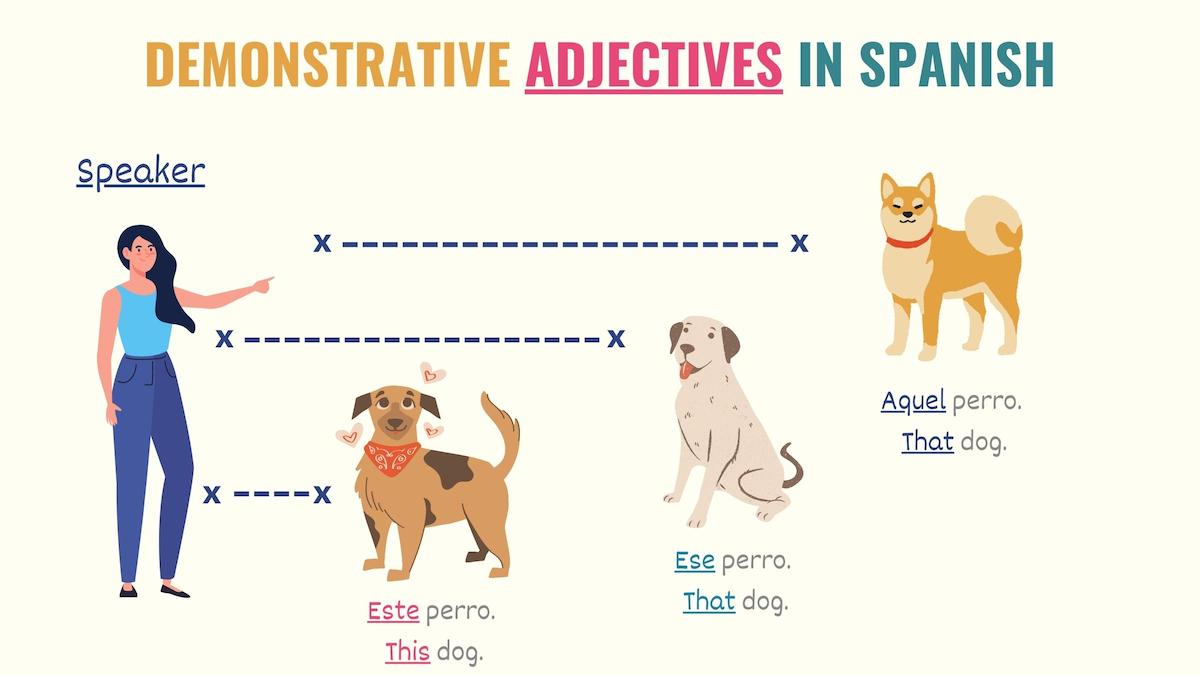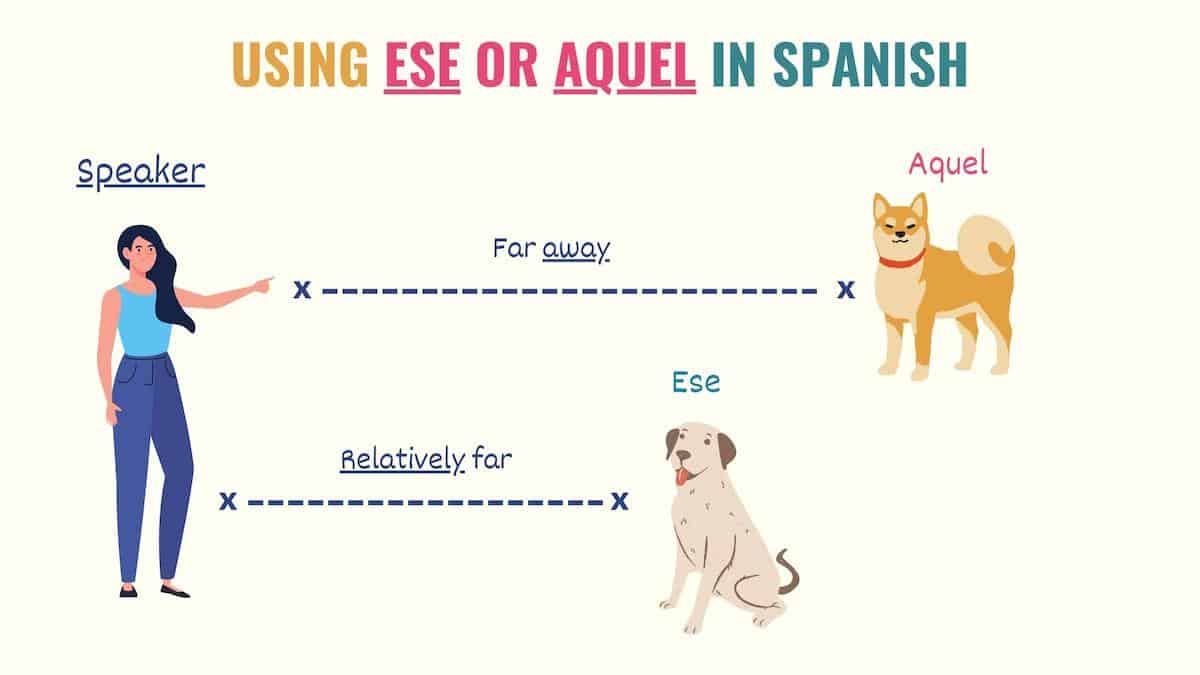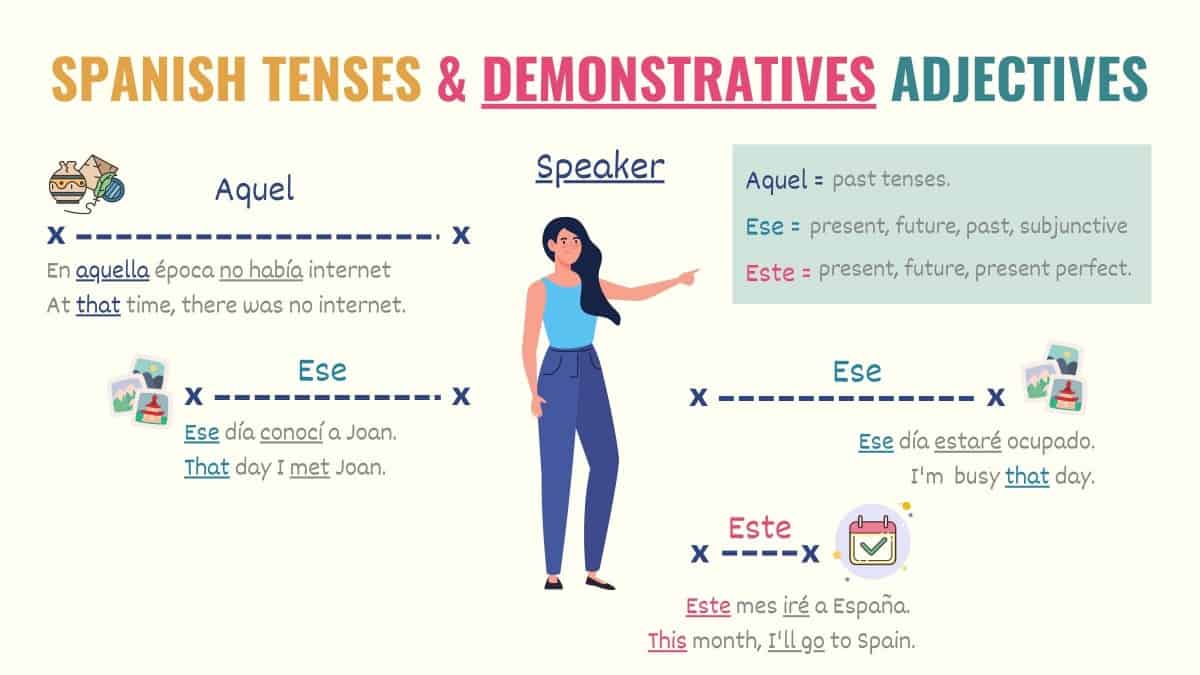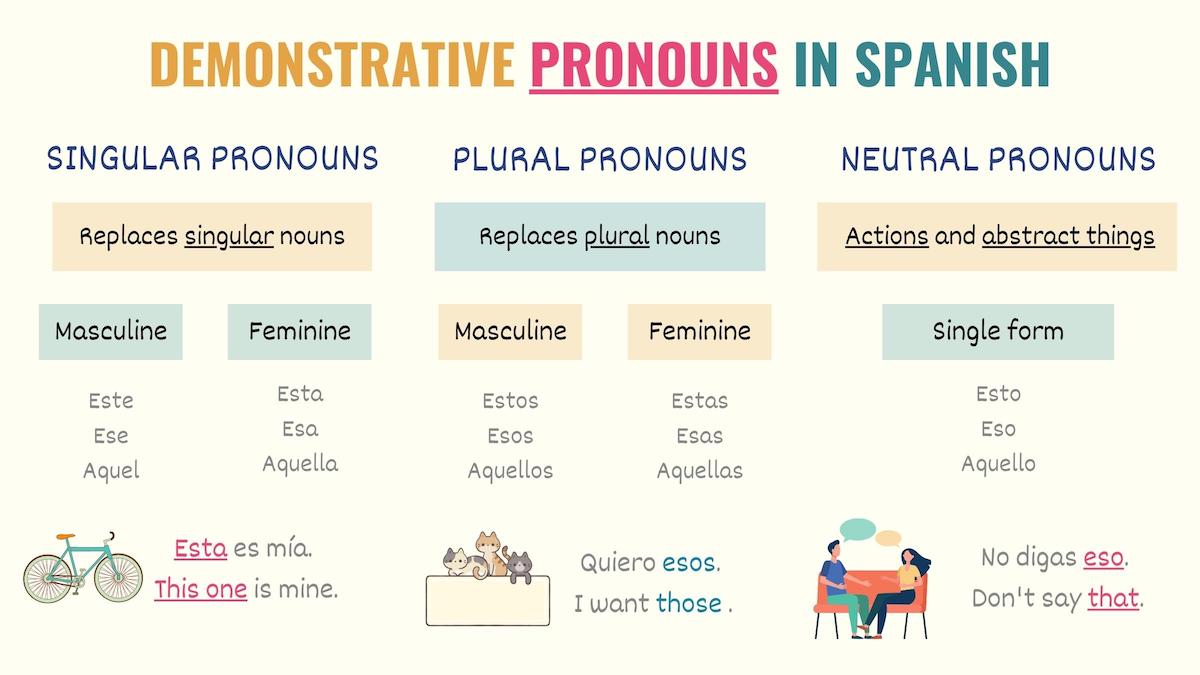According to the data collected by El Corpus del Español, most demonstratives are in the top 40 most frequently used words in Spanish. However, many learners still wonder what demonstrative adjectives in Spanish are.
Spanish demonstrative adjectives indicate where a person or thing is located in relation to the speaker. There are three basic types of demonstrative adjectives – este, ese, and aquel. Using one adjective over another depends on the distance between the noun and the speaker.
Demonstratives in Spanish are essential. After all, they help you indicate how far something or someone is. So, in this guide, I’ll provide you with the key information you need to know to use these words.
- Spanish Demonstrative Adjectives and Chart
- How to Use Demonstrative Adjectives
- Demonstrative Adjectives vs Demonstrative Pronouns
- Bonus: Common Adverbs + Demonstratives
- Key Points
- Video Lessons
List of Demonstrative Adjectives in Spanish
Depending on the spatial or temporal distance they express, demonstrative adjectives in Spanish are classified into three basic groups:
- Este: the noun is very close in relation to the speaker.
- Ese: the noun is somewhat far.
- Aquel: the noun is far away from the speaker.
Like any other Spanish adjective, demonstratives must agree in number and gender with the noun. So, in total, we have twelve demonstrative adjectives in Spanish.
Below, you’ll find charts with all demonstrative adjectives. Remember that the distance is always in relation to the speaker.
Singular demonstrative adjectives
| Masculine Pronoun | Feminine Pronoun | Distance | English |
|---|---|---|---|
| Este | Esta | Nearby | This |
| Ese | Esa | Relatively far | That |
| Aquel | Aquella | Far away | That |

Plural form of Spanish demonstrative adjectives
| Masculine Pronoun | Feminine Pronoun | Distance | English |
|---|---|---|---|
| Estos | Estas | Close by | These |
| Esos | Esas | Relatively far | Those |
| Aquellos | Aquellas | Far away | Those |
[Demonstrative] + [noun]
Me gustan estos dulces.
I like these candies.
Aquellas flores son tuyas.
Those flowers are yours.
Esos niños rompieron la ventana.
Those kids broke the window.
Take Note: Both aquel and ese mean ‘that’. But even if they share the same translation, they do not express the same idea. ‘Aquel’ refers to things or people that are further in distance or time from the speaker.

How to Use Demonstrative Adjectives in Spanish
Spanish demonstrative adjectives have a simple purpose: to identify something (or someone) and describe how close or far they are from the speaker. A noun always follows demonstrative adjectives.
Below are some sentences using demonstrative adjectives in Spanish. Look how the adjectives perfectly match the number (singular or plural) and the gender of the noun.
[Demonstrative adjectives] + [noun]
¿De quién son estas camisas?
Who are these t-shirts from?
Ese celular es tuyo.
That phone is yours.
Aquella tienda está muy surtida.
That store is well stocked.
Esos muchachos están muy guapos.
Those boys are very handsome.
Demonstrative adjectives in Spanish are not only used when talking about things or people that you can see or touch. In fact, we also use them to talk about time, ideas, and abstract concepts.
Check the examples below:
[Demonstrative adjectives] + [noun]
Esta tarde voy a ir al cine.
This afternoon I’m going to the movies.
Ese día hacía mucho frío.
That day was very cold.
En aquel tiempo, no había internet.
At that time, there was no internet.
No conozco estas palabras.
I don’t know these words.
Pay attention to examples #1 to #3. All of them refer to time. Can you see the temporal distance? Esta tarde is very close in time, so I can use the near future to tell you about my plans.
On the other hand, the demonstratives in examples #2 and #3 are far away from this moment. For that reason, they work as time markers for the preterite and the imperfect tense in Spanish.

So, based on the temporary distance, here are some combinations you can use with demonstratives and Spanish tenses:
- Este and its variations: present, present perfect and near future.
- Ese and its variations: preterite, imperfect, and future.
- Aquel and its variations: past tenses.
Difference Between Demonstrative Adjectives and Pronouns
In Spanish, both demonstrative adjectives and pronouns are used to indicate how far something is in relation to the speaker. The difference between them is that adjectives must be followed by a noun, while demonstrative pronouns are used to replace such a noun.
In simple words, demonstrative adjectives and demonstrative pronouns in Spanish have the same purpose. As you’ll see in the examples below, their only difference is the elements they work with. Adjectives must go with a noun, and pronouns are used instead of that noun to avoid repetition.
Examples of demonstrative adjectives
Quiero esta camisa.
I want this t-shirt.
Voy a leer este libro.
I’m going to read this book.
Examples of demonstrative pronouns
Quiero esta.
I want this.
Voy a leer ese.
I’m going to read that.
You use demonstrative pronouns when anyone in the conversation understands the noun you’re referring to. As you can see in the previous examples, pronouns help you avoid repetition and keep your sentences shorter.
For the most part, demonstrative pronouns in Spanish are exactly the same words as demonstrative adjectives.

But a significant distinction between these sets of words is that, unlike adjectives, demonstrative pronouns have a neuter form:
- Esto
- Eso
- Aquello
These pronouns are always used in this single form and are only applied when replacing concepts, actions, and abstract things.
Eso ya lo veremos.
We’ll see that.
Esto no tiene sentido.
This doesn’t make sense.
Aquello estuvo mal.
That was wrong.
Bonus: Adverbs that Work with Demonstratives
Certain Spanish adverbs work together with Spanish demonstratives. These adverbs are:
- Aquí – here / now
- Ahí – there / then
- Allí – there / then
- Allá – there / then
Have you ever struggled with these words? Don’t feel bad; many students do.
These adverbs work exactly like demonstratives in Spanish. In other words, they help you express the distance between the speaker and a noun.
In Spanish, we can use these adverbs and demonstratives at the same time. Can you imagine why? To emphasize sentences 😉 Now, you only need to make sure that the adverb and the demonstrative refer to the same distance.
Check these sentences:
[Demonstrative] + [noun] + de + [adverb]
Me gusta esa camisa de ahí.
I like that t-shirt over there.
¿Este coche de aquí es tuyo?
Is this car over here yours?
Aquella chava de allá es mi prima.
That girl over there is my cousin.
Key Points
Demonstratives in Spanish are essential for daily communication. Here are some key points that you must remember:
- Spanish demonstratives identify an object and express its distance from the speaker.
- Demonstrative adjectives are always followed by a noun.
- Demonstrative adjectives must agree with the gender and number of a noun.
- Spanish demonstratives are used based on the distance you want to express. They can describe a physical or temporal distance.
- ‘Este’, and its variations, are used for objects that are close to the speaker.
- ‘Ese’, and its formal and plural forms, is for nouns that are relatively far from the speaker.
- ‘Aquel’, and its variations, refer to objects that are very far away from the speaker.
- While demonstrative adjectives work with a noun, demonstrative pronouns in Spanish replace them.
Watch the Video Lesson
Watch the Spanish Immersion Lesson!
I record all my video lessons in English and Spanish immersion so you have lesson content regardless of your comprehension level. Click the thumbnail to watch the demonstrative adjectives in Spanish lesson to practice your comprehension skills.

